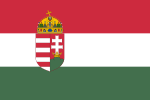Royal Hungarian Army
| Hungarian National Army Magyar Nemzeti Hadsereg (1919–1920) Royal Hungarian National Army Magyar Királyi Nemzeti Hadsereg (1920–1922) Royal Hungarian Army Magyar Királyi Honvédség (1922–1945) |
|
|---|---|

Infantry colour of the Royal Hungarian Army (1939–45)
|
|
| Active | 6 June 1919 – 8 May 1945 |
| Country |
|
| Type | Army |
| Size | 115,447 (1920) 35,000 (1921) 57,648 (1930) 85,332 (1937) 1,000,000 (1944) |
| Garrison/HQ | Budapest |
| Nickname(s) | MKH |
| Motto(s) |
Királyért és hazáért "For King and Country" |
| Anniversaries | 28 June |
| Engagements | |
| Commanders | |
| Supreme Warlord |
Miklós Horthy (1919–44) Ferenc Szálasi (1944–45) |
| Commander-in-Chief |
Pál Nagy (1922–25) Hugó Sónyi (1936–40) |
| Chief of the General Staff |
Viktor Lorx (1922) Károly Beregfy (1944–45) |
| Notable commanders |
Károly Beregfy Lajos Csatay Elemér Gorondy-Novák Gusztáv Jány Géza Lakatos Dezső László Béla Miklós Vilmos Nagy Lajos Veress |
| Insignia | |
| Insignia (1942–1945) |
 |
| War Flag (1919–1939) |
 |
| War Flag (1939–1945) |
 |
| Royal Hungarian River Guard Magyar Királyi Folyamőrség (1921–1939) Royal Hungarian Army River Forces Magyar Királyi Honvéd Folyami Erők (1939–1945) |
|
|---|---|
| Active | 1 March 1921 – 8 May 1945 |
| Country |
|
| Type | Brown-water navy |
| Size | c. 1700 personnel |
| Garrison/HQ | Budapest |
| Engagements | |
| Commanders | |
| Commander | Olaf Richárd Wulff (first) (1921–1933) Ödön Trunkwalter (last) (1944–1945) |
| Insignia | |
| Naval Ensign (1921–1939) |
 |
| Naval Ensign (1939–1945) |
 |
Subcarpathia
Slovak–Hungarian War
World War II
The Royal Hungarian Army (Hungarian: Magyar Királyi Honvédség, German: Königlich Ungarische Armee) was the name given to the land forces of the Kingdom of Hungary in the period from 1922 to 1945. Its name was inherited from the Royal Hungarian Landwehr which went under the same Hungarian title of Magyar Királyi Honvédség from 1867 to 1918. Initially restricted by the Treaty of Trianon to 35,000 men, the army was steadily upgraded during the 1930s and fought on the side of the Axis powers in the Second World War.
As a vanquished power in the First World War, Hungary had hardly grown at all in the immediate post-war years thanks to the territorial demands of its old and new neighbouring states, the Kingdom of Rumania, Czechoslovakia and the Kingdom of Serbs, Croats and Slovenes. The Hungarian Red Army that was formed during the period of the Hungarian Soviet Republic, in which many world war veterans enlisted, was defeated by the allied armies in the Hungarian–Romanian war of 1919. The consequence was that large areas of Hungary were occupied and many regions that Hungary had claimed were finally lost.
In July 1919 the former Commander-in-Chief of the Austro-Hungarian Navy, Admiral Miklós Horthy, had begun to set up the "National Army" (Hungarian: Nemzeti Hadsereg) as directed by the opposition government. This was supported by former k.u.k. officers like Gyula Gömbös, Döme Sztójay and Anton Lehár. After the withdrawal of Rumanian troops in 1919/20 they took over the defence of the country, but remained dependent on the goodwill of the victorious powers that had met at the Paris Peace Conference.
...
Wikipedia
